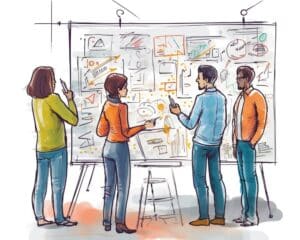Le design thinking est porteur de promesses pour les managers. Il s’agit d’appliquer la pensée et les méthodes des designers pour favoriser l’innovation dans son team. Bénéfices attendus : plus d’efficacité pour gérer les équipes, plus de creativity pour résoudre les problèmes, plus de bien-être pour augmenter la productivité. Mais comment transposer la méthode du design thinking au management ? France Selvides, formatrice pour ORSYS et experte en management des organisations, en fait la démonstration à travers des exemples concrets.

Design thinking: definition and benefits for companies
Le design thinking est une méthode éprouvée depuis plus de 30 ans par David Kelly et Tim Brown au sein d’IDEO, entreprise de design et de conseil, pour créer des nouveaux produits et services. C’est une approche systémique centrée sur l’utilisateur, qu’il soit client interne ou externe à l’organisation. Elle est reconnue pour son efficacité dans la problem solving complexes pour innover.
The 5 principles of design thinking
1
Working together
2
Iteration
3
Creativity
4
An optimistic state of mind
5
Concrete visualisation of product or service ideas and concepts
3 "main times" but 5 stages
In its entirety, the design thinking process breaks down into the following elements 3 main stages :
- first of all, get to grips with the context of the problem to be solved
- then, catalyse creativity to find solutions
- finally, implement the chosen solution
In pragmatic terms, however, design thinking takes place by 5 steps :
- La première repose sur l’empathy : il s’agit d’observer et comprendre en profondeur les besoins exprimés et les besoins latents des utilisateurs.
- The second defines the real problem to be addressed from the user's point of view.
- The third is the ideation of realistic solutions.
- The fourth involves simple and very inexpensive prototyping to give tangible form to the innovative solution we have in mind.
- Lastly, the fifth stage is an opportunity to test and evaluate, and adjust the final solution if necessary.
Please note: At each stage, continuous improvement is formalised through rapid iteration loops.
[Training] Applying the thinking and methods of designers while encouraging innovation in your team: that's the ambition of design thinking. Would you like to enhance your practices, gain a better understanding of your employees' expectations and guide your team towards finding and implementing innovative solutions? Find out more about the training programme: Managers: use design thinking with your teams
What are the benefits of design thinking for businesses?
Cela facilite la decision-making.
It is a tool for creativity and innovation.
Company processes are optimised at the right cost.
The method encourages project group work in a positive, proactive environment.
This exceptional approach fosters team cohesion, team motivation and a sense of belonging to the company.
Example of the use of design thinking
Dominique, Marketing Project Manager, is tasked with enhancing the customer experience of her range of in-flight entertainment products. To achieve this, she must launch a new application in 3 months. To ensure that it was simple and easy for users to use, she decided to adopt a design thinking approach. So she put together a team of 5 managers from other departments, including Claude, a web developer, and Andréa, an R&D engineer. Naturally curious, but with very little time to spare, Claude was particularly reluctant to make time for this project. Andréa, who is passionate about artificial intelligence, is over-solicited by industrial projects of strategic importance. They both fail to see the point of joining the team.
For encourage their involvement, Dominique les invite alors à participer à 5 ateliers de 3 heures étalés sur 6 semaines. Elle anime chaque atelier avec de nouveaux outils d’idéation utilisés par les designers. Toutes les idées des participants sont brassées et challengées par rapport aux contraintes techniques et informatiques. Dominique déploie également une active listening et stimule leur créativité en utilisant des variants de brainstorming. Surpris par la démarche, Claude et Andréa apprécient que leurs avis soient pris en compte. Ils s’impliquent donc de plus en plus. Ils se prennent au jeu au point où, en dehors des ateliers, ils continuent d’échanger sur le projet. À la fin du processus, les participants délivrent l’application souhaitée dans les délais et sans budget complémentaire.
Claude and Andréa are proud to have contributed so effectively. They have also understood the benefits of the method. In turn, they decided to training in design thinking to generate a new management dynamic in their own teams.
Taking advantage of design thinking to innovate your managerial approach
Managers have seized on the method. They have adapted and used the designers' tools to renew their team management practices. For example, the empathy card. This is an in-depth questionnaire for interviewing users. It encourages them to express their unspoken perceptions and needs in relation to the problem to be solved.
Applied at managerial level, design thinking opens up new areas for exploration and experimentation. It allows employees to be involved in new projects in an atmosphere that is participative, positive and respectful of well-being in the workplace. In practical terms, this means using collaborative creative tools.
Testimonial
"Thanks to design thinking, I feel more like a project manager than an HR manager.
Floriane Lalloyeau, project manager officer, Bayer
I started out as a manager in the human resources department, before becoming project manager officer after taking a design thinking course for a corporate project with a high business impact.
This design thinking course helped me on several levels. Firstly, in understanding and embracing design thinking. Secondly, it helped me to put myself in other people's shoes, to understand what they expect from me and from the HR department. And even to get rid of my HR jargon!
For me, design thinking is a genuine decision-making method. In my day-to-day work, applying design thinking cultivates my curiosity and open-mindedness. On the one hand, it allows me to adopt a listening posture. On the other, it enables me to adapt my approach to managing multicultural aspects. I now feel more like a project manager than an HR manager. Now, when faced with any new request from our employees, my colleagues start by asking "What is the problem we need to solve? In other words, identifying the 'real' problem to be solved from the user's point of view.
Developing a new managerial dynamic with your team using design thinking
Design thinking enables managers to develop their skills in :
- active listening using empathy
- creativity using tools such as brainstorming and its 20 variants, mind mapping, the 6 hats methodetc.
[Also read]
How can you boost your team's creativity and productivity?
The 6 Hats method enables all aspects of a situation or problem to be discussed. Each team member is invited to observe a situation from several angles. Each angle is symbolised by a hat of a different colour. As a team, the aim is to identify :
1 - Factual and neutral elements (white hat)
2 - Potential issues and risks (black hat)
3 - Positive aspects (yellow hat)
4 - Induced emotions (red hat)
5 - Ideas for improvement (green hat)
6 - To conclude with a final selection of response elements (blue hat)
Managers can use these tools in group workshops to gain a better understanding of their team's needs.
Dans un état d’critical thinking constructif, ils insufflent alors une nouvelle dynamique managériale. Leurs collaborateurs retrouvent du sens au travail et se sentent motivés car alignés avec les objectifs business et la stratégie d’entreprise.
Case study: design thinking in action
ENVOL (name changed) is a mobility company with 350 employees. Between 2019 and 2025, it needs to resize its capacity in anticipation of increased passenger traffic. It is therefore planning several construction and redevelopment projects: car parks, pedestrian signage and related services (catering, shopping, relaxation areas). These are all opportunities to improve the customer experience and quality of service as part of an innovative approach. Self-service check-in, for example.
The management team is also seizing this opportunity to get employees involved in the innovation strategy and experiment with continuous improvement on issues with a high economic impact. The Head of HR Development and 6 other managers from different departments volunteered to take the innovation approach required during this period of transition.
1st stage: they follow a 3 days to innovation management and discover design thinking. They practise the method based on a problem raised by passengers.
The training takes place in their dedicated creativity room. Modular furniture, a spacious room, movable panels, erasable whiteboards, posters outlining the company's innovation programme... The working conditions are comfortable and conducive to establishing a creative state of mind.
The first day enables them to build a common language of innovation. Next, the managers experiment with the design thinking method, focusing on the challenges they see in ensuring employee performance during this period of transition. They identified a number of challenges to be met. First, they sorted the issues using a criteria grid inspired by the Eisenhower matrix and their intuition. Next, they selected a major recurring issue: "How can we guarantee well-being at work? Finally, they go through the 5 phases of design thinking during the course.
A few months later, they revisit this challenge with their respective teams. to devise and select the 3 best solutions. This experiential action enabled them to unite all the employees and weld the departments together. As a result, ENVOL came through this period of major change without too much turbulence.
In conclusion, design thinking is an invaluable asset for managers wishing to reinvent their practices. This human-centred approach stimulates creativity, improves problem solving and creates a climate of collaboration within teams. Managers gain in agility and adapt their decisions more effectively to the real expectations of their staff. This creates a more innovative and forward-looking management style.





